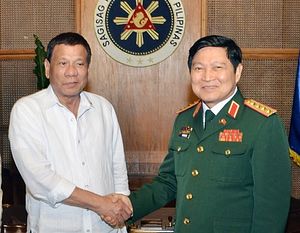Last week, Vietnam and the Philippines held another iteration of a bilateral naval exchange. The interaction underscored the ongoing maritime collaboration between the two South China Sea claimant states amid wider developments in their domestic and foreign policies.
As I have noted before in these pages, Vietnam and the Philippines, two fellow claimants in the South China Sea, have been attempting to strengthen their maritime collaboration as part of their broader relationship for several reasons, including China’s growing assertiveness in the South China Sea. The two sides have come up with a range of mechanisms as part of this over the past few years, from hotlines to working groups, to facilitate confidence-building.
One of these arrangements was a 2012 protocol for bilateral naval exchanges on Southwest Cay, currently occupied by Vietnam, and Northeast Cay, occupied by the Philippines, where the two sides would rotate naval personnel exchanges between their two features which lie just a few miles from each other, with a series of people-to-people interactions and information sharing. At the time, the interaction between the two countries was hailed as an example of intra-ASEAN confidence building in the South China Sea at a time of heightened tensions, particularly given the history of the struggle between the two Southeast Asian countries to control the two features.
Since then, both sides have attempted to implement the protocol. While there was a periodic pause in this process following the election of Philippine President Rodrigo Duterte in 2016, it was subsequently resumed in 2017. And the last personnel interaction was held on Northeast Cay/Song Tu Dong Island back in November 2018.
Last week, this aspect of Vietnam-Philippines South China Sea interactions was in the headlines again with the holding of another interaction of the naval personnel interaction. The fifth personnel interaction between the two countries was held in Southwest Cay/Song Tu Tay Island on September 10. It occurred amid a series of developments in the South China Sea, including continued tensions between China and Vietnam and suggestions of a potential resource sharing agreement between China and the Philippines.
The activity between forces on both sides consisted of a series of interactions. Per Vietnam’s defense ministry, the two sides discussed and shared information related to maritime interactions in the islands as well as issues of mutual concern, such as anti-piracy, smuggling, illegal immigration, maritime accidents, and natural disasters. They also held artistic exchanges and sports engagements including volleyball and tug of war.
The two leaders of the delegations of the two countries – Nguyen Viet Thuan, the Deputy Commander of Naval Region 4 of the Vietnam People’s Navy, and, Tagamolila, the Commander of Naval Task Force 41 of the Philippine Navy – also reflected on the activity. In their remarks, Thuan noted the significance of the event for both sides in building a peaceful and stable environment in the South China Sea and for the implementation of the Declaration on the Conduct of Parties in the South China Sea, while Tagamolila noted the importance of the development for fostering mutual trust and understanding between the two navies.
Unsurprisingly, few specifics were disclosed about the engagement, including details about future upcoming iterations. Nonetheless, it continues to be among the interactions to monitor to get a sense for how both countries are managing their maritime collaboration and the South China Sea issue more specifically.

































